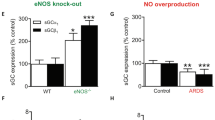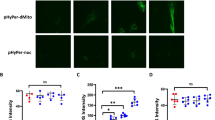Abstract
We previously reported that exposure to exogenous nitric oxide (NO) causes diminished expression of thioredoxin/thioredoxin reductase, a critical component of the redox system that regulates the functions of redox-sensitive enzymes, receptors, and transcription factors. Here we examined the role of thioredoxin in NO-induced inhibition of protein kinase C (PKC) isoform(s) and potential interaction of PKC and thioredoxin in pulmonary artery endothelial cells (PAEC) in culture. Exposure to NO gas (8 ppm) significantly diminished the catalytic activity of the representative isoforms of the conventional, novel, and atypical PKCs α,ε, and ζ, respectively, in PAEC. Further examination of NO's effect on PKC-ζ revealed that NO-induced inhibition of the catalytic activity of PKC-ζ was time-dependent and regulated by a posttranscriptional mechanism. NO-induced loss of the catalytic activity of PKC-ζ was restored by incubation with the disulfide reducing agent dithiothreitol (DTT) as well as by purified thioredoxin or thioredoxin reductase. Confocal imaging studies revealed co-localization of PKC and thioredoxin in PAEC. These results indicate that: (1) NO-induced inhibition of PKC isoforms is associated with S-nitrosylation-mediated disulfide formation of active site thiols in PKC-ζ as the disulfide reducing agent DTT and/or the thioredoxin enzyme system restore PKC-ζ catalytic activity and (2) NO causes oxidation of endogenous thioredoxin as exogenous reduced thioredoxin or thioredoxin reductase are required to reduce thioredoxin and to restore the catalytic activity of PKC-ζ in PAEC.
Similar content being viewed by others
References
Vallance P, Collier J: Biology and clinical relevance of nitric oxide. Br Med J 309: 453-457, 1994
Steudel W, Hurford WE, Zapol WM: Inhaled nitric oxide: Basic biology and clinical implications. Anesthesiology 91: 1090-1121, 1999
Hampl V, Herget J: Role of nitric oxide in the pathogenesis of chronic pulmonary hypertension. Physiol Rev 80: 1337-1372, 2000
Pepke-Zaba J, Higenbottam TW, Dinh-Xuan AT, Stone D, Wallwork J: Inhaled nitric oxide as a cause of selective pulmonary vasodilation in pulmonary hypertension. Lancet 338: 1173-1174, 1991
Kubes P, Ganger DN: Nitric oxide modulates microvascular permeability. Am J Physiol Heart Circ Physiol 262: H611-H615, 1992
Palmer RMJ, Bridge L, Foxwell NA, Moncada S: The role of nitric oxide in endothelial cell damage and its inhibition by glucocorticoids. Br J Pharmacol 105: 11-12, 1992
Patel JM, Zhang JL, Block ER: Nitric oxide-induced inhibition of lung endothelial cell nitric oxide synthase via interaction with allosteric thiols: Role of thioredoxin in regulation of catalytic activity. Am J Respir Cell Mol Biol 15: 410-419, 1996
Zhang JL, Velsor LW, Patel JM, Postlethwait EM, Block ER: Nitric oxide-induced reduction of lung cell and whole lung thioredoxin expression is regulated by NFκB. Am J Physiol Lung Cell Mol Physiol 277: L787-L793, 1999
Patel JM, Block ER: Sulfhydryl-disulfide modulation and the role of disulfide oxidoreductases in regulation of the catalytic activity of nitric oxide synthase in pulmonary artery endothelial cells. Am J Respir Cell Mol Biol 13: 352-359, 1995
Gopalakrishna R, Chen ZH, Gundimeda U: Nitric oxide and nitric oxide-generating agents induce a reversible inactivation of protein kinase C activity and phorbol ester binding. J Biol Chem 268: 27180-27185, 1993
Shizukuda Y, Tang S, Yokota R, Ware JA: Vascular endothelial growth factor-induced endothelial cell migration and proliferation depend on a nitric oxide-mediated decrease in protein kinase Cδ activity. Circ Res 85: 247-256, 1999
Jun CD, Choi BM, Lee SY, Kang SS, Kim HM, Chung TH: Nitric oxide inhibits the expression of protein kinase Cδ gene in the murine peritoneal macrophages. Biochem Biophys Res Commun 204: 105-111, 1994
Park SK, Lin HI, Murphy S: Nitric oxide regulates nitric oxide synthase-2 gene by inhibiting NFκB binding to DNA. Biochem J 322: 609-613, 1997
Peng HB, Libby P, Liao JK: Induction and stabilization of IκB-α by nitric oxide mediates inhibition of NFκB. J Biol Chem 270: 14214-14219, 1995
Matthews JR, Botting CH, Pasnico M, Morris HR, Hay RT: Inhibition of NFκB DNA binding by nitric oxide. Nucleic Acid Res 24: 2236-2241, 1996
Colasanti M, Persichini T: Nitric oxide:An inhibitor of NFκB/Rel system in glial cells. Brain Res Bull 52: 155-161, 2000
Kolpakov V, Gordon D, Kulik T: Nitric oxide generating compounds inhibit total protein synthesis and collagen synthesis in cultured vascular smooth muscle cells. Circ Res 76: 305-309, 1995
Bundy RE, Marczin N, Chester AH, Yacub M: A redox-based mechanism for nitric oxide-induced inhibition of DNA synthesis in human vascular smooth muscle cells. Br J Pharmacol 129: 1513-1521, 2000
Powis G, Briehl M, Oblong J: Redox signaling and the control of cell growth and death. Pharmacol Ther 68: 149-173, 1995
Hayashi T, Veno Y, Okamoto T: Oxidoreductive regulation of nuclear factor κB: Involvement of a cellular reducing catalyst thioredoxin. J Biol Chem 268: 11380-11388, 1993
Matthews JR, Wakasugi N, Virelizier JL, Yodoi J, Hay RT: Thioredoxin regulates the DNA binding activity of NF-κB by reduction of disulfide bond involving cysteine 62. Nucleic Acid Res 20: 3821-3830, 1992
Holmgren A: Thioredoxin structure and mechanism: Conformational changes on oxidation of the active site sulfhydryls to disulfide. Structure 3: 239-243, 1995
Watson JA, Rumsby MG, Wolowacz RG: Phage display identifies thioredoxin and superoxide dismutase as novel protein kinase C-interacting proteins: Thioredoxin inhibits protein kinase C-mediated phosphorylation of histone. Biochem J 343: 301-305, 1999
Witte S, Villalba M, Bi K, Liu Y, Isakov N, Altman A: Inhibition of the c-jun N-terminal kinase/AP-1 and NF-κB pathways by PICOT, a novel protein kinase C-interacting protein with a thioredoxin homology domain. J Biol Chem 275: 1902-1909, 2000
Nishizuka Y: Intracellular signaling by hydrolysis of phospholipids and activation of protein kinase C. Science 258: 607-614, 1992
Hug H, Sarre TF: Protein kinase C isozymes: Divergence in signal transduction. Biochem J 291: 329-343, 1993
Gopalakrishna R, Jaken S: Protein kinase C signaling and oxidative stress. Free Rad Biol Med 28: 1349-1361, 2000
Folgucira L, McElhinny JA, Bren GD, MacMorran WS, Diaz-Mcco MT, Moscat J, Paya CV: Protein kinase C-ζ mediated NF-κB activation in human immunodeficiency virus-infected monocytes. J Virol 70: 223-231, 1996
Dominguze I, Sanz L, Arenzana-Seisdedos F, Diaz-Meco MT, Virelizier JL, Moscat J: Inhibition of protein kinase C-ζ subspecies blocks the activation of NF-κB like activity in Xenopus laevis oocytes. Mol Cell Biol 13: 1290-1295, 1993
San-Antonio B, Iniguez MA, Fresno M: Protein kinase C-ζ phosphorylates nuclear factor of activated T cells and regulates its transactivating activity. J Biol Chem 277: 27073-27060, 2002
Hussain S, Assender JW, Bond M, Wong LF, Murphy D, Newby AC: Activation of protein kinase C-ζ is essential for cytokine-induced metalloproteinase-1,-3, and-9 secretion from rabbit smooth muscle cells and inhibits proliferation. J Biol Chem 277: 27345-27352, 2002
Patel JM, Edwards DA, Block ER, Raizada MK: Effect of nitrogen dioxide on surface membrane fluidity and insulin receptor binding of pulmonary artery endothelial cells. Biochem Pharmacol 37: 1497-1507, 1988
Zhang JL, Li, YD, Patel JM, Block ER: Thioredoxin overexpression prevents NO-induced reduction of NO synthase activity in lung endothelial cells. Am J Physiol Lung Cell Mol Physiol 275: L288-L293, 1998
Kazanietz MG, Areces LB, Bahador A, Mischak H, Goodnight J, Mushinski JF, Blumberg PM: Characterization of ligand and substrate specificity for the calcium-dependent and calcium-independent protein kinase C isozymes. Mol Pharmacol 44: 298-307, 1993
Winer BJ: In: Statistical Principles in Experimental Design. New York, McGraw-Hill, 1971, pp 210-219
Patel JM, Abeles AJ, Block ER: Nitric oxide exposure and sulfhydryl modulation alter L-arginine transport in cultured pulmonary artery endothelial cells. Free Rad Biol Med 20: 629-637, 1996
Bren GD, Pennington KN, Paya CV: PKC-ζ associated CK2 participates in turnover of free IκB-α. J Mol Biol 297: 1245-1258, 2000
Li J, Billiar TR, Talanian RV, Kim YM: Nitric oxide reversibly inhibits seven members of the caspase family via S-nitrosylation. Biochem Biophys Res Commun 179: 442-448, 1997
Mohr S, Stamler JS, Brune B: Posttranscriptional modification of glyceraldehyde 3-phosphate dehydrogenase by S-nitrosylation and subsequent NADH attachment. J Biol Chem 271: 4209-4214, 1996
Marshall HE, Stamler JS: Inhibition of NF-kappa B by S-nitrosylation. Biochemistry 40: 1688-1693, 2001
Xian M, Chen X, Liu Z, Wang K, Wang PG: Inhibition of papain by S-nitrosylation. J Biol Chem 275: 20467-20473, 2000
Stamler JS, Lamas S, Fang FC: Nitrosylation: The prototypic redoxbased signalingmechanism. Cell 106: 675-683, 2001
Patel JM, Li YD, Zhang JL, Gelband CH, Raizada MK, Block ER: Increased expression of calreticulin is linked to ANG-IV-mediated activation of lung endothelial NOS. Am J Physiol Lung Cell Mol Physiol 277: L794-L801, 1999
Nishida E, Koyasu S, Sakai II, Yahara I: Calmodulin regulated binding of 90-kDa heat shock protein to actin filaments. J Biol Chem 261: 16033-16036, 1986
Author information
Authors and Affiliations
Rights and permissions
About this article
Cite this article
Kahlos, K., Zhang, J., Block, E.R. et al. Thioredoxin restores nitric oxide-induced inhibition of protein kinase C activity in lung endothelial cells. Mol Cell Biochem 254, 47–54 (2003). https://doi.org/10.1023/A:1027380828645
Issue Date:
DOI: https://doi.org/10.1023/A:1027380828645




